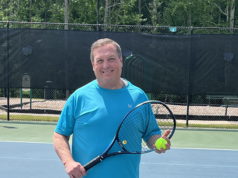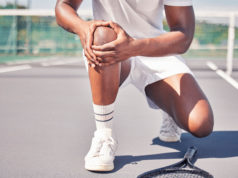Warm-up exercises and stroke techniques to stay injury-free
By Shane Mangrum, MD, board-certified physiatrist at Polaris Spine & Neurosurgery Center
Balance is often taken for granted, yet when you slip or fall you think otherwise. Usually, falls are not a concern for young people as they just get back up and carry on. However, balance is essential for older adults; falling and breaking a hip can be the beginning of a downward spiral.
Tennis is a great sport for keeping active throughout any stage of your life, but it is important to keep in mind the safety and health of your spine. As with any sport or physical activity, warming up is essential. Tennis strokes require a considerable amount of trunk rotation, and therefore spine rotation. Completing warm-up exercises before getting onto the court can help prevent muscle strain and lower back spasms. Trunk twists and arm circles are just two exercises that can help loosen up your muscles. If you have experienced or are currently experiencing back pain during tennis, it may be a good idea to incorporate back-specific exercises into your routine. Try exercises like hip crossover stretches or cat-cows to alleviate lumbar tension.
The serve is by far one of the riskiest moves in tennis with concern to potential injury. This move hyper-extends the lower back and can compress lumbar discs — and this can be a recipe for back trouble. The hyperextension of the lower back can stress the small joints in the spine, lumbar discs, as well as the muscles, ligaments, and tendons around the spine. A serve with a lot of top spin requires a lot of extension. A back-friendly alternative serve is the slice serve. During a slice serve, your racket approaches the ball from the side rather than from above, lessening the chance of injury to your back.
Learning proper shot techniques is extremely important, especially when it comes to avoiding back injuries. Just one serve, overhead, volley, or groundstroke could be between you and a back strain or injury. A professional tennis coach can teach you optimal hitting stances, ways of connecting to the ball, and follow-through motions to keep your spine safe. Players who experience back pain also may benefit from learning a one-handed backhand. This shot can ease some of the rotational stress that a two-handed backhand can put on the spine. Your coach also can teach you spine-safe techniques for tennis practice. For example, when doing drills, you should avoid excessive repetition of a single kind of shot, such as an overhead. This repetition can put a lot of strain on the muscle groups used to perform the shot, making you vulnerable to injury. When you’re working with your coach, make sure to let them know if you are feeling any pain or discomfort while playing. It’s important to listen to your body!
Whether it be chasing a ball cross-court or running to the net to make a volley, your back muscles must support you during these continual and sudden forward and lateral movements. A great way to support your back is adding core strengthening exercises into your routine. As in all sports, strong core body muscles are vital and can help prevent injuries to other parts of the body, including the back.
The right tennis equipment also can make or break you. Always wear proper tennis shoes with good shock absorption and traction. Make sure you are using the right tennis racquet with the proper string tension. And never play on a wet and slippery court. Your local tennis pro is an excellent source of advice on what equipment is best suited to you and most likely to minimize unnecessary stress on your back muscles.
If your back pain is persistent and your at-home remedies aren’t working, it is a good idea to seek professional help. At Polaris Spine, we have two board-certified physiatrists, medical doctors that specialize in physical medicine and rehabilitation. Our physiatrists believe in a holistic approach to pain relief and can help prescribe you a back-specific exercise plan to help you get back on the court and back in the swing.




